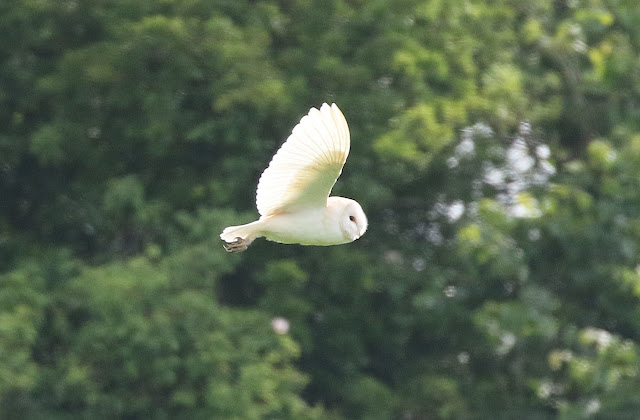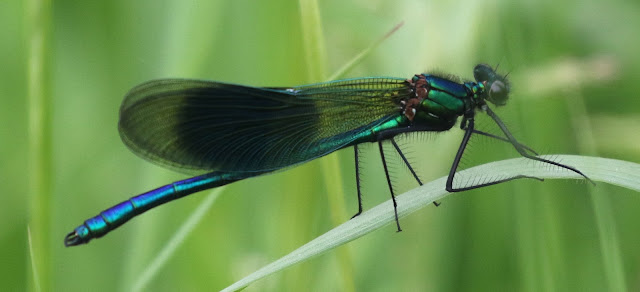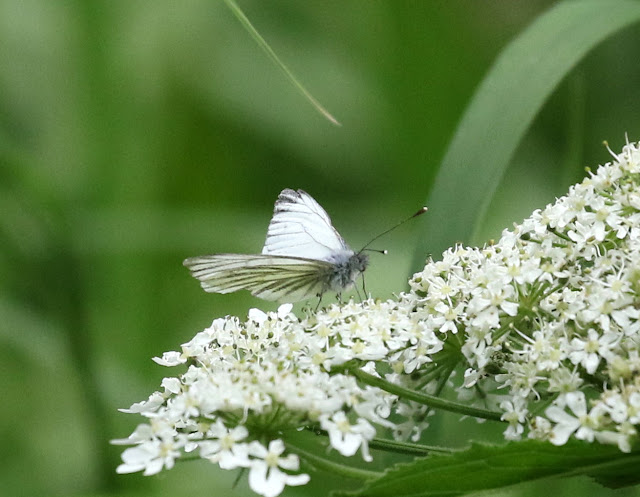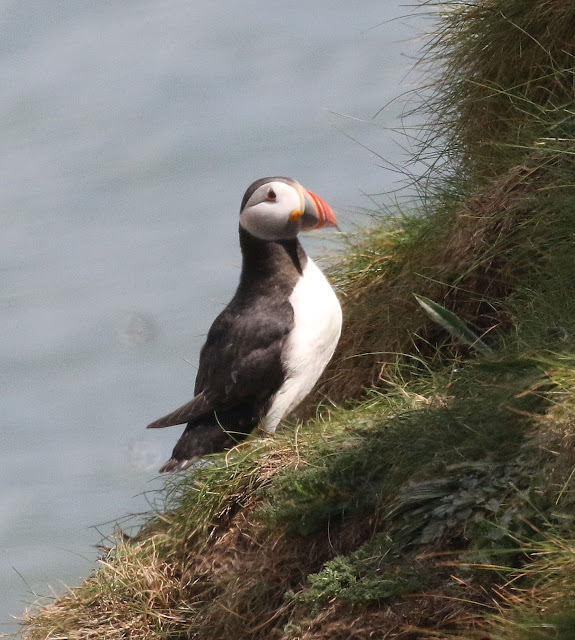On Tuesday the weather was supposed to stay fair until the afternoon, so we went ahead with Skerne Wetlands. Most of the class met at Watton and shared cars from there. As we waited a Barn Owl was out hunting from 9.05 onwards. We watched him hunt unsuccessfully for nearly 20 mins, but eventually he plunged to the earth, and was invisible in the long grass for several minutes before he re-emerged with his prey in his talons - a Short-tailed Vole. He took it directly to his nest which appeared to be low down in a heavily wooded hedge-line.
Barn Owl
Hunting
Changing Course
Rear View
Taking Off Again
Having a Rest
Starting out again
Barn Owl
ditto
Over grass
Taking the Plunge
Off again
The Prize - a Short-tailed Vole
Reed Bunting
Swallow
Tree Sparrow
Tufted Ducks
Sedge Warbler
Damselfly
Banded Demoiselle
Marsh Frog
Peacock
Red Admiral
Wall Brown
Hairy Dragonfly
ditto
Marsh Orchid
On Wednesday a nice day was forecast, so we went ahead with Pocklington Canal. Unfortunately, it was much greyer, cooler and windier than forecast. From the car park we had House Sparrows, Starlings, Swifts, House Martins, Swallows and a very noisy Song Thrush. There were wicker sculptures of a Crane, a wading bird and a horse near the parking area.
Spotted Flycatcher
Whitethroat
Along the earlier part of the canal we heard and saw several Yellowhammers and a Chiffchaff, and a Reed Warbler. There was no sign of any Sedge Warblers here or elsewhere along the canal we traversed. In the afternoon a Whitethroat was busy collecting insects in the area. There were families of young Great Tits, Blue Tits and Moorhen during the walk. Blackcaps serenaded us during certain parts of the walk. Baby Wrens were heard, and Goldcrests sang but remained under cover. We saw three different pairings of Bullfinches, but only one of these was visible after lunch.
Juvenile Great Tit
Reed Bunting
Immature Moorhen
Song Thrush
Bullfinch
At the area just before a derelict house both groups saw a silent Cuckoo - this was probably a female watching over the activities of the Reed Warblers. In the morning a Willow Warbler was singing here. Across the fields a vast number of Rooks were taking advantage of an unguarded feeder. Pheasants were here too, and Jackdaws. Several years ago a Turtle Dove was seen and heard in this area, but this was long gone. A pair of Swans with a total of 8 cygnets were sailing on the Canal.
Rooks
Mute Swans
ditto
Collared Dove
Yellowhammer
Red-legged Partridge (c) 2019
Carpet Moth Species (c) 2019 Maggie Bruce
Chimney Sweeper (c) 2019 Maggie Bruce
Chimney Sweeper
Green-Veined White
ditto
Roach
Roach
Bladder Campion
Buttercups and Ragged Robin
The journey back was pretty uneventful. However, the afternoon group were nearly back when Sally saw a bird twisting and turning after an insect - it was a Spotted Flycatcher! this was the first one on a Weds pm for some time, and we enjoyed watching it for more than 10 minutes, and we left it still catching insects.
Record Shot of Spotted Flycatcher
Spotted Flycatcher
Wicker Crane
On Thursday the forecast had been rather dodgy, but it turned out to be the best weather of the week not too windy, brighter, and dry. We started off as usual and walked along the cliff top. The first Whitethroat was just beyond the car park. There were a few Puffins visible from the first little inlet - “Rock Doves” too.
Puffin
Whitethroat
Soon we were assaulted by the subtle, but repetitive song of Meadow Pipits. The usual cliff top walk disappeared here, as the coastal path had eroded during the winter months. We had good views of Skylarks along the fence, usually standing on tall tussocks.
Meadow Pipit
Meadow Pipit (c) 2019 Paul Green
Meadow Pipit
ditto
Skylark
Ditto
Ditto
Skylark (c) 2019 Margaret Richardson
Skylark - white outer tail feathers
Ditto
We arrived at the normal sheer cliff face, and this time there were a great number of Razorbills in the top right hand corner, always being joined by more. There were Guillemots, including a bridled version, a few Puffins towards the foot of the cliff, whilst Fulmars, Kittiwakes and Herring Gulls flew around our heads.
Razorbill
Ditto
Razorbills (c) 2019 Margaret Richardson
Razorbill (c) 2019 Margaret Richardson
ditto
Guillemot [bridled example centre front]
Fulmar
Kittiwake (c) 2019 Dave Hill
Herring Gull (c) 2019 Dave Hill
The next stopping off point brought us our best view of Puffins, in the grass with the sea as a backdrop. Shags were also visible from here, but these were distant either drying themselves on rocks by the sea, flying low over the water, or sitting in their alcove on one of the pinnacle rocks. A few Small Coppers were seen in the grass.
Puffin
Ditto
Ditto
Ditto
ditto
Shags with Guillemots & Razorbills
The walk to the hide produced several Linnets, one with a very blood-red breast. Elaine spotted a Yellowhammer. There were a few Sand Martins over the Marsh, plus Coots. Whitethroats were on the bushes near to the hide, and a Reed Bunting was spotted by a class member who shall be nameless. One surprise was a leucitic Blackbird, which looked very odd.
Linnet
ditto
Not as red as the other
linnet
Leucistic Blackbird
Red Admiral
Small Copper
ditto
Birds'-foot Trefoil
Marsh Orchid
Marsh Orchids (c) 2019 Margaret Richardson
Yellow Flag Iris (c) 2019 Margaret Richardson
Scarlet Pimpernel
And now some Gannets taken at Bempton during half-term.
Gannet (c) 2019 Dave Hill
Ditto
Ditto
On Friday we carried on with our visit to MSQ, even though the afternoon looked doubtful. Again there was no Garden Warbler in the car park, but we heard many later on. It may have been the most noticeable numerous singing summer visitor. In the afternoon these were replaced by Blackcaps.
Jay
A Great Crested Grebe and a well-grown chick were on the first lake. A Common Tern on the raft was seen to have at least 2 chicks. A male Cuckoo was heard calling distantly.
Garden Warbler
The walk through the woodland resulted in many sheltering damselflies. In the afternoon we saw a Kingfisher. The fishing lake resulted in three drake Red-Crested Pochard and some Egyptian Geese with their young on the far bank. There were also several Tufted Duck and Oystercatchers.
Red-Crested Pochard
Immature Blackcap
From the first hide there weren’t as many ducks as usual, but we did spot Shelduck, Shoveler, and a pair of Pochard. On the walk past the reedbeds we heard a bubbling female Cuckoo, but we weren’t able to spot her.
Egyptian Goose
Egyptian Geese
The Wader Hide didn’t have any waders apart from Lapwings. When a pair of Egyptian Geese arrived the Black-headed Gulls didn’t take kindly to them. After we had left this area and were watching a family of Wrens a male Cuckoo was heard from the location we had just vacated. Walking past the gorse bushes we saw a Jay on a fence post. It flew away, but we soon relocated this and another in the tussocky field.
Immature Wren
Jay
Jay
Jay
Jay
ditto
We saw a Jay again as we walked through the conifer plantation, but there was little else in this area.
Exuvia of Emerged Dragonfly
Longhorn Micro Moth - Nemophora fasciella
ditto
Possible female Hairy Dragonfly
Large Yellow Underwing
2 Friday students went to Ness End at half-term, and saw a recently emerged family of Blue Tits.
Blue Tits at Ness End (c) 2019 Jane Robinson
ditto
ditto























































































































No comments:
Post a Comment